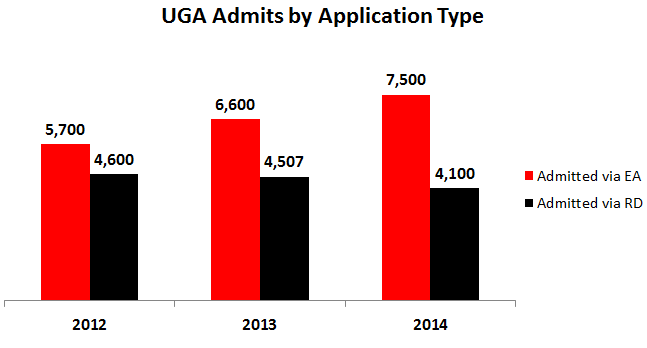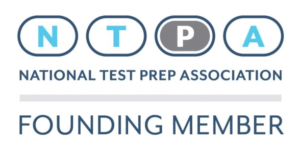All About UGA: Ruminations from the 2014 UGA Admissions Process
UGA is a school of particular interest to many of our clients, so we wanted to do a deep dive into some UGA admissions trends that we’ve observed over the past two years.
1) A markedly larger share of the class was admitted via Early Action (EA) instead of Regular Decision (RD).
The table below shows an interesting trend from 2012-2014. The portion of students admitted via EA has grown from 55% to 65% from 2012 to 2014 while the proportion of the applicant pool that applies EA has remained constant.


2) Superscoring is having an increased impact on SAT/ACT score averages.
Just 3,002 people in Georgia got a single-day ACT score of 30 or higher last year, yet 30 was both the median and average score for UGA. 75% of UGA admits submitting an ACT had a 28+ this year, yet only 5,568 Georgians had an ACT of 28 or higher. But UGA admitted over 11,600 people this year, and not every high-scoring applicant even applies to UGA. How is that possible?
Yes, many students submitted their SAT scores, but a huge contributing factor is that UGA “superscores” both the ACT and SAT (combines the best section scores from different dates). It’s a real game-changer. Savvy parents and students understand the power of superscoring far better than they did just 3-4 years ago, driving average SAT/ACT scores at virtually all schools upwards.
Also, remember that people tend to fib about their scores; fewer than 400 students earned a single-day 34, 35, or 36 last year in the entire state of Georgia (about 2.5 per county), and some of those weren’t even students — they were Edison Prep’s own tutors taking the test to stay on top of their game!
3) Academic rigor continues to be far more important than extracurricular activities.
This April, Senior Associate Director of UGA Admissions David Graves posted a quote on the UGA Blog that we sincerely wish were included at the top of every UGA mailing:
“When parents or students say that their schedule is already so busy with other activities that it is tough to handle challenging courses…instead of dropping rigorous courses, maybe an activity could be dropped.”
We tell students daily that no one has ever been ever rejected for having too low of a “play practice score,” but millions of applications are rejected each year for low GPA, low rigor, and/or low SAT/ACT scores. Activities matter if and once your core academic metrics are in the right ballpark. Fun Fact: 95% of students admitted to UGA in 2013 had at least one AP class. Avoiding that AP goose egg is crucial.
4) Applying Early Action is becoming paramount.
Here’s an academic snapshot of admitted students from 2012-2014:

The UGA Admissions Blog goes to great lengths to explain to commenters that it is not easier or harder to be admitted EA vs. RD; it’s just a different timeline. As you can see in the table above, the academic stats for the full admitted pool vs. EA-only are pretty similar quantitatively, which just further strengthens the argument for applying early. It’s likely that if the high-flying UGA Honors College applicants were removed from the rest of the EA pool, the resulting EA vs. RD stats would be identical.
What we can definitively state is that, by all means, unless you think that your statistics are so poor that you’ll be rejected during Early Action, apply during Early Action. Only about 7% of students get rejected via EA (about 1/3 are deferred). We know of many RD applicants who were waitlisted or rejected with far better stats than their counterparts who applied and were accepted via EA from the same high school. As the table in item #1 illustrates, there are fewer spots left during Regular Decision than in years past. Therefore, students should try to compete while a reasonable number of spots still remain. Doing so implies trying to finish up your standardized testing by June of junior year at the latest (though EA applicants are still allowed to submit SATs/ACTs through the October exams).
The UGA Regular Decision rejection stories you heard this year might feel slightly more intense than reality because there are two waves of RD students who are admitted. RD students who applied RD but who had similar (if not superior) academic profiles to the EA admit pool are admitted far earlier (in February). Thus, the only UGA rejections you hear about happen all at once in late March, alongside a much smaller number of late March RD admissions (the second wave).
5) Closing Thoughts:
We’ve tutored approximately 1,500 students in the past three years from over 60 high schools and over 20 Georgia counties, the vast majority of whom applied to UGA. In those 3 years, we can count on one hand the number who were admitted with scores lower than 26 (ACT) or 1770 (SAT). The inflection points that we tend to see are around a 29 and a 1920.
Planning to be one of those outliers is risky; simply planning and attempting to hit the upper end of that mid-50%, or as close to it as possible, is the smart move.
If UGA is on your student’s list, we’d highly encourage you to read the UGA Admissions Blog regularly. UGA has one of the most responsive and high-touch blogs of any college admissions blog we’ve seen; David Graves does an amazing job.
Feel free to email us with questions at edison@edisonprep.com!
Note: The numerous sources that went into this article are listed here.







